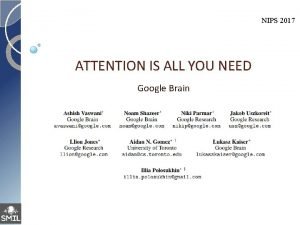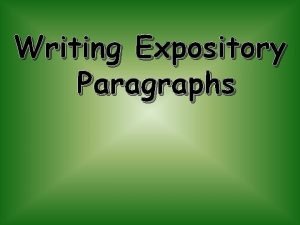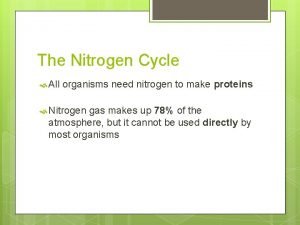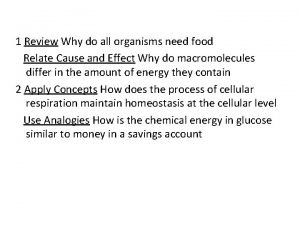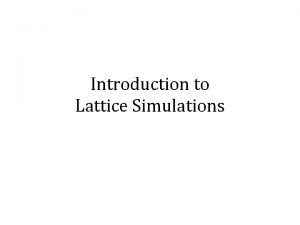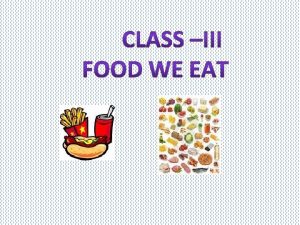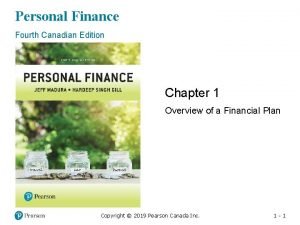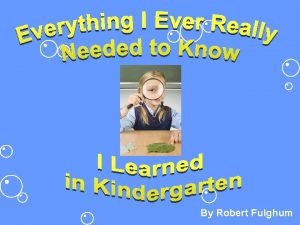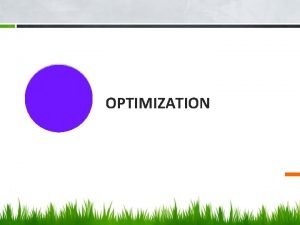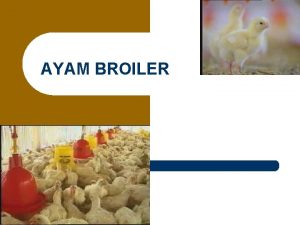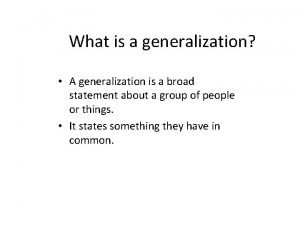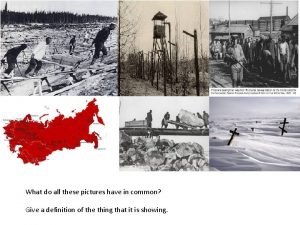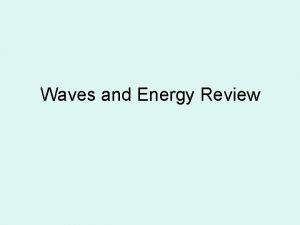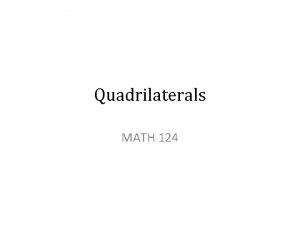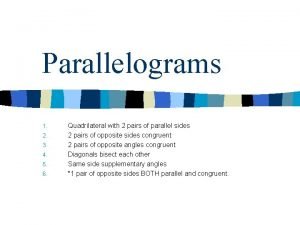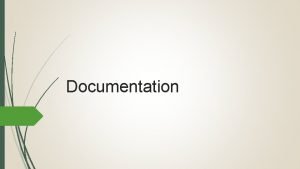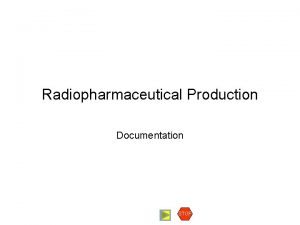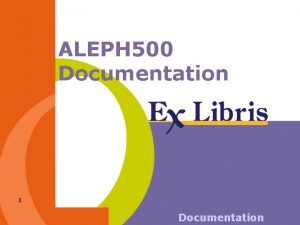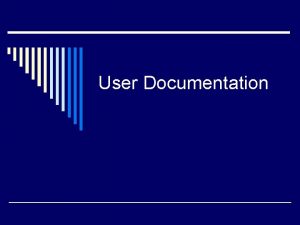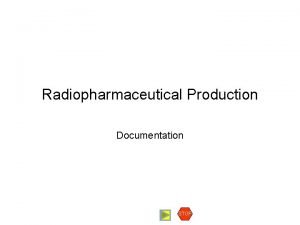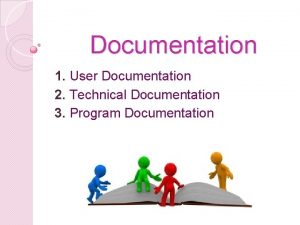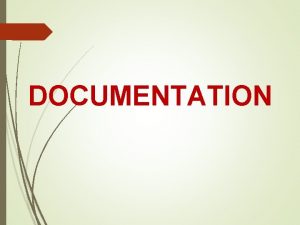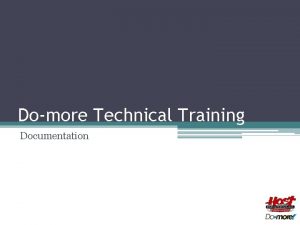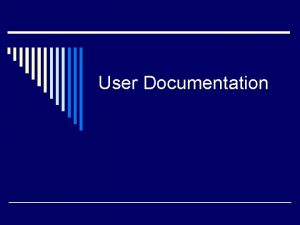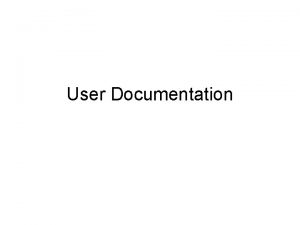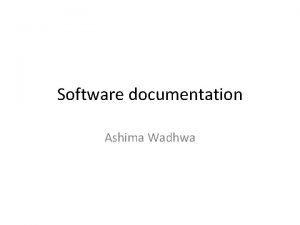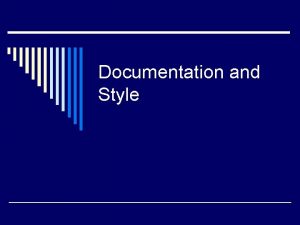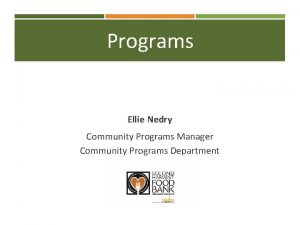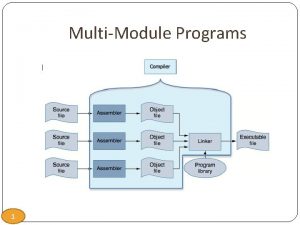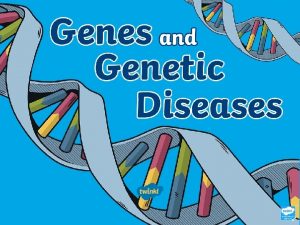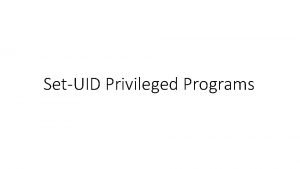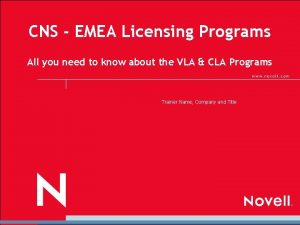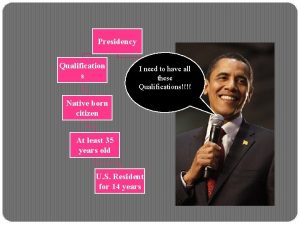Documentation Need to have documentation in all programs


































- Slides: 34

Documentation • Need to have documentation in all programs – Documentation header – Regular comments inside programs – Follow department standard • Copy-and-paste shell command in Putty – Highlight the part to copy – Right-click to paste Copyright © 2007 Pearson Education, Inc. Publishing as Pearson Addison-Wesley 1

Review • • • Q. What does #include do? Q. What is namespace std? Q. How many main( ) function(s)? Q. What does a preprocessor do? cout<<“Hello “<< “World!”<<endl; • “n” and endl Copyright © 2007 Pearson Education, Inc. Publishing as Pearson Addison-Wesley 2 -2

Variable • Named memory location • Used to hold data – Name – Type • Different type holds different kinds of data – Capacity • How large is this location? • Determined by type – Duration • Gets recycled after lifetime is over Copyright © 2007 Pearson Education, Inc. Publishing as Pearson Addison-Wesley 2 -3

To define a variable • Specify type and name int num; // reserve a location of four bytes in RAM // used for storing an integer // reference the location using name num • Define several variables of same type in an instruction int rate, hour, pay; //reserve three locations with four bytes each Copyright © 2007 Pearson Education, Inc. Publishing as Pearson Addison-Wesley 2 -4

Rules for choosing variable names • • Use numbers, letters, underscore Cannot start with number Cannot be keywords Make it meaningful • C++ is case sensitive! – Hour and hour are two different variables! Copyright © 2007 Pearson Education, Inc. Publishing as Pearson Addison-Wesley 5

Valid and Invalid variable names IDENTIFIER VALID? REASON IF INVALID total. Sales total_Sales total. Sales 4 th. Qtr. Sales total. Sale$ Copyright © 2007 Pearson Education, Inc. Publishing as Pearson Addison-Wesley 2 -6

Valid and Invalid variable names IDENTIFIER VALID? REASON IF INVALID total. Sales Yes total_Sales Yes total. Sales No Cannot contain. 4 th. Qtr. Sales No Cannot begin with digit total. Sale$ No Cannot contain $ Copyright © 2007 Pearson Education, Inc. Publishing as Pearson Addison-Wesley 2 -7

Variable Type: Integer • positive and negative whole numbers, e. g. 5, -52, 343222 • short, int, long • represented internally in binary 16 is represented as 00010000 • To define: int number; Copyright © 2007 Pearson Education, Inc. Publishing as Pearson Addison-Wesley

Variable Type: Floating point number • Real number (integral and fractional part) 2. 5, 3. 6666, -. 000034, 5. 0 • float, double, long double • Stored internally as mantissa and exponent (base 2) 16. 0 is represented as mantissa 1. 0 and exponent 4 Copyright © 2007 Pearson Education, Inc. Publishing as Pearson Addison-Wesley

Variable Type: Floating point number • To define: – float amount; – double hour, rate; Copyright © 2007 Pearson Education, Inc. Publishing as Pearson Addison-Wesley 10

Variable Type: Boolean • Logical variable • Named for George Boole • Values: true and false • To define: bool flag; Copyright © 2007 Pearson Education, Inc. Publishing as Pearson Addison-Wesley

Variable Type: Character • represent individual character values E. g. ’A’ ’a’ ’ 2’ ’*’ ’”’ ’ ’ • stored in 1 byte of memory • special characters: escape sequences ’n’ ’b’ ’r’ ’t’ ‘’’ • To define: char letter; Copyright © 2007 Pearson Education, Inc. Publishing as Pearson Addison-Wesley

string type • A sequence of characters – Can contain zero or more character – “” empty string – “A” string with one char – “Hello” string with five characters Copyright © 2007 Pearson Education, Inc. Publishing as Pearson Addison-Wesley

string type • Be careful with single and double quotes (“ versus ")when using word processor • Not a primitive type (size varies) – A string can have arbitrary number of characters Copyright © 2007 Pearson Education, Inc. Publishing as Pearson Addison-Wesley

To define a string • Same syntax //reserve 2 or 4 bytes to store the //address of the string //store the string dynamically in //another place string course_name; Copyright © 2007 Pearson Education, Inc. Publishing as Pearson Addison-Wesley 15

In summary • For whole numbers – short (2 bytes) – int (4 bytes) – long (4 or 8 bytes) • For floating point numbers • For Boolean (true/false) values – bool (1 bit) • For string – string (varies) – float (4 bytes) – double (8 bytes) • For single character – char (1 byte) Copyright © 2007 Pearson Education, Inc. Publishing as Pearson Addison-Wesley 2 -16

More examples float x, y; int num 1, num 2; float salary; string flower_name; Copyright © 2007 Pearson Education, Inc. Publishing as Pearson Addison-Wesley

Assignment operator = • Two-step action – Evaluate the value of right hand side – Assign the value to left hand side int num num num; = 5; = num + 1; = num * 2; = num * num; Copyright © 2007 Pearson Education, Inc. Publishing as Pearson Addison-Wesley 2 -18

Left hand side must be a variable 12 = item; // ERROR! Left hand side does not reference a location a + 5 = a; //Same error Copyright © 2007 Pearson Education, Inc. Publishing as Pearson Addison-Wesley 2 -19

Variable initiation • Combine variable declaration and initial assignment into a single instruction int num = 5; //declare an integer variable num //assign 5 to num • Can also write them separately int num; num = 5; Copyright © 2007 Pearson Education, Inc. Publishing as Pearson Addison-Wesley 2 -20

Variable declaration without initial values • An uninitialized variable has a random value, i. e. we do not know what value is stored int num; char letter; float rate; Copyright © 2007 Pearson Education, Inc. Publishing as Pearson Addison-Wesley 21

Literal vs. Variable • A literal is a value that is written into a program’s code. "hello, there" (string literal) 12 (integer literal) ‘C’ (character literal) 3. 5 (floating point number literal) • Value of a literal cannot be changed. 3 is always 3. • Value of a variable can be changed. Copyright © 2007 Pearson Education, Inc. Publishing as Pearson Addison-Wesley 2 -22

20 is an integer literal 2 -23 Copyright © 2007 Pearson Education, Inc. Publishing as Pearson Addison-Wesley

This is a string literal 2 -24 Copyright © 2007 Pearson Education, Inc. Publishing as Pearson Addison-Wesley

This is also a string literal 2 -25 Copyright © 2007 Pearson Education, Inc. Publishing as Pearson Addison-Wesley

Output a variable • The current value of the variable will be printed • Don’t enclose a variable name in double quotes int num= 5; num = num * num; cout << "The value of num is " << num << endl; Copyright © 2007 Pearson Education, Inc. Publishing as Pearson Addison-Wesley 2 -26

More examples char letter = 'c'; //declare letter, assign ‘c’ to letter //don’t forget single quote Q. What about the following? char letter = c; //c is considered as a variable //Error! may or may not compile Copyright © 2007 Pearson Education, Inc. Publishing as Pearson Addison-Wesley 27

More examples bool flag = true; // true is a keyword string name = "John"; //use double quote string name = John; // Error! John is treated as a variable name Copyright © 2007 Pearson Education, Inc. Publishing as Pearson Addison-Wesley 28

Define before use Copyright © 2007 Pearson Education, Inc. Publishing as Pearson Addison-Wesley 2 -29

What is the output? int a=5, b=7, c=10; a = a + 3; b = a + c; cout << a << " " << b << " " << c << endl; Every object (string, variable, or manipulator) needs a separate << in a cout instruction. //Error! cout << a << " " << b << " " c << endl; Copyright © 2007 Pearson Education, Inc. Publishing as Pearson Addison-Wesley 30

Characters and strings • A character is stored as its ASCII value (Appendix B) – – ‘A’ 65 ‘B’ 66 ‘y’ 121 ‘$’ 36 • A string is stored as a sequence of characters – “John” – Always has the NULL character (‘�’) at the end 74 111 104 110 � Copyright © 2007 Pearson Education, Inc. Publishing as Pearson Addison-Wesley 2 -31

‘A’ and “A” • Q. Are they the same? • 'A' is a single character, stored in 1 byte of memory 65 • "A" is a string of length one, stored as 2 bytes of memory 65 � 2 -32 Copyright © 2007 Pearson Education, Inc. Publishing as Pearson Addison-Wesley

Summary • Variable basics – How to declare and initialize – Various types – Assignment operator – Difference between characters and strings – Output variable values using cout • Literals Copyright © 2007 Pearson Education, Inc. Publishing as Pearson Addison-Wesley 2 -33

Review • Section 2. 3 Variable types and declarations • http: //www. cppforschool. com/tutorial/varia ble-memory-concept. html Copyright © 2007 Pearson Education, Inc. Publishing as Pearson Addison-Wesley 34
 Collection of programs written to service other programs.
Collection of programs written to service other programs. Draw three noncollinear points j k and l
Draw three noncollinear points j k and l 12 edges 6 faces
12 edges 6 faces Attention is all you need
Attention is all you need Love is not all about
Love is not all about Write an expository paragraph
Write an expository paragraph Why do organisms need nitrogen?
Why do organisms need nitrogen? Why do all organisms need food
Why do all organisms need food I wish you much strength
I wish you much strength All we need
All we need Protective food
Protective food All i need is the air that i breathe and to love you abba
All i need is the air that i breathe and to love you abba Money is all you need
Money is all you need Fulghum all i really need to know
Fulghum all i really need to know We need to enclose a field with a fence. we have 500 feet
We need to enclose a field with a fence. we have 500 feet Let's be good friends
Let's be good friends Hebrews 10:36 sermon
Hebrews 10:36 sermon Love all serve all help ever hurt never meaning in hindi
Love all serve all help ever hurt never meaning in hindi Interventi sociali rivolti alla persona
Interventi sociali rivolti alla persona Crucified laid behind the stone
Crucified laid behind the stone I work all night
I work all night Communication operations
Communication operations Sistem all in all out
Sistem all in all out Mesothenar
Mesothenar Silent night holy night all is calm
Silent night holy night all is calm 馮定華神父
馮定華神父 All of you is more than enough for all of me
All of you is more than enough for all of me She's all states and all princes i
She's all states and all princes i Here in the power of christ i stand
Here in the power of christ i stand Above all powers
Above all powers What is a generalization
What is a generalization What do all these pictures have in common
What do all these pictures have in common What do all waves have in common
What do all waves have in common Do all quadrilaterals have lines of symmetry
Do all quadrilaterals have lines of symmetry Given quadrilateral talk is a parallelogram
Given quadrilateral talk is a parallelogram



